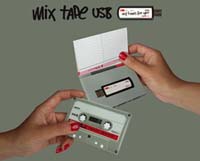The Death of the Mix
Published on January 30th, 2008 in: Current Faves, Issues, Music, Science and Technology |By Christian Lipski

Photo © Richard Jones
I used to make mix tapes all the time when I was growing up. I liked the idea of creating a single object or concept by combining existing songs, like making a quilt or a collage. When I was done, the tape was to be taken as a cohesive whole, not as individual tracks; that was the ultimate goal.
When recordable CDs became affordable, I was excited to begin a new phase in mix-making. CDs were more durable than cassettes after all, and computer software would allow you to assemble mixes even more efficiently than before. Or so I thought. It’s true that sound-editing programs provide the ability to make creative, cleaner-sounding mixes, but the flip side is that now there are too many possibilities, and that has killed the mix for me.
I always wanted to be able to cross-fade songs together on mixes, especially when the first song has a very long fade-out and the next one has a long fade-in. The listener is forced to wait for both before the real “meat” of the song begins. Now it’s possible to layer sounds over one another and adjust their volumes over time, so that you don’t have to stop a fade before it’s done—you can start the new song during the fade, just like they do on the radio or in the clubs. If the songs have the same tempo, this can create an interesting segue as one seems to move seamlessly to the next. You can keep the music continuous between the songs, so that they’re presented as more of a unified thought. The ability to layer sounds also lets you drop in sounds from other sources, like quotes from movies or sound effects, and enhance the whole experience.

Suck UK’s Mix Tape USB Drive
Another pet peeve for mix-makers is that music from different media (or even the same medium) is often mastered at different volumes, which results in sudden drops in volume during the mix. Many times I have found a perfect song for the mix only to have it play at half the volume of the rest of the mix. If you forget to turn the stereo volume down while you’re listening to it, the next track is going to shock you to your senses. There is software now that allows you to adjust the gain of all the mix tracks, or conversely, to normalize the soft song so that it’s more uniformly loud. I’ve also used this to make songs with soft passages louder while still keeping the louder parts from clipping, so that you don’t need to turn up the volume during the softer parts. It alters the intended design of the songwriter or producer, but a mix is a customized experience anyway, so I’m okay with it.
I only recently began actually editing the songs themselves in terms of length and structure. If you only have 45 or 80 minutes available for music, you want to get as much in as possible, and usually that excludes songs that are overly long since they either don’t fit in the time left or they would prevent other songs from being included. For example, I had wanted to include a Rufus Wainwright song, “Old Whore’s Diet,” on mixes, but at 8:54 it just wasn’t worth leaving out two other songs to put it in. I finally realized that I could map the song into verses, choruses, and instrumental passages, and pick and choose which I wanted to keep in. The final edit contained what I felt to be the important parts of the song, and was a tidy four minutes in length.
Pages: 1 2
Time limit is exhausted. Please reload the CAPTCHA.